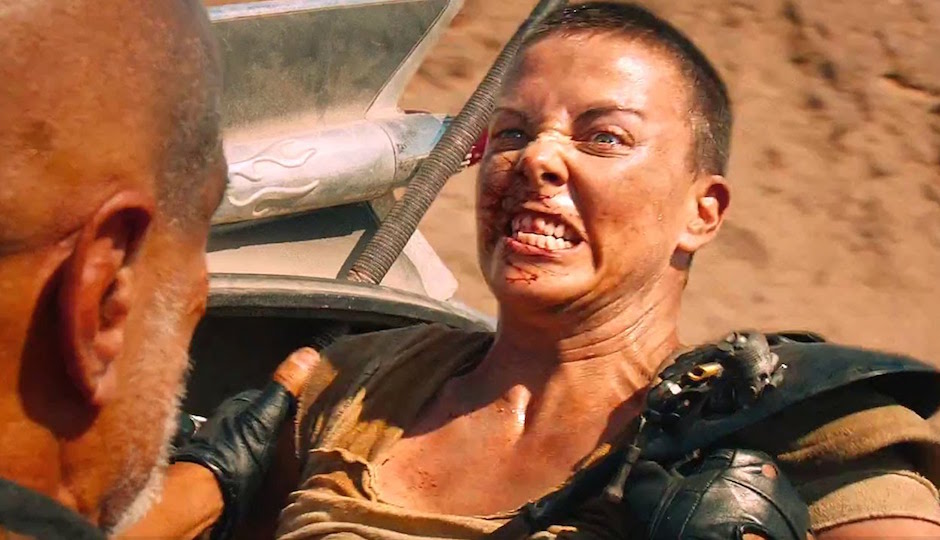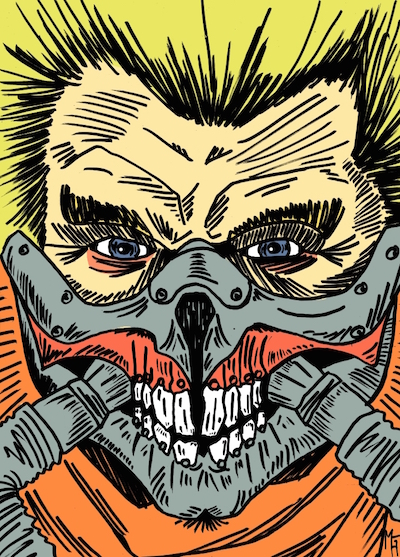Exit Review: Mad Max: Fury Road is the Best Movie of the Year
There’s so much to say about Mad Max: Fury Road. But a lot of it has been said already, coughed out in excited hyperventilations by movie reviewers who needed some Xanax and a change of pants after sitting through what is definitely the best movie of the year so far. I’ve changed my pants, and a week after seeing it am feeling pretty groovy, so here’s the Fury Road exit review, using the classic Grierson and Leitch film review style to make sure my excited ramblings don’t smush together and gum up my thoughts.
1. I have been mad at Tom Hardy since they cast him as Bane in The Dark Knight Rises.

Tom Hardy in Mad Max: Fury Road.
I mean, it’s not his fault that they cast all five feet of his obviously British ass to convey the most unstoppable, intellectual, and Portuguese foe that Batman has ever faced. But it is his fault that he played it with no fervor, assuming an accent that no one on Earth has, and actor-ing it so hard that the last generation of Bane was completely foreign to comic book fans. He’s got a habit of actor-ing things up, though, unnecessarily and cloyingly. Tinker Tailor Soldier Spy. Lawless. Branson. He put so much sauce on those roles that you could barely taste the meat.
But knowing that he finally has his very own buccoo-bux franchise and that he must play Gibson’s Max Rockatansky has put Hardy in a lovely rut. We can’t hear his atrocious faux-Australian accent too much, because Max is largely a silent hero. We can’t see him posture weirdly because Max is always either driving or running from someone. So we’re left with the exact right amount of Tom Hardy, the guy who gives us a Max Max who is both noticeably mad, and pretty much the same Max — with slightly goofier facial expressions.
Congrats, Hardy. You’re off my shitlist.
2. Aeon Flux was the movie that made me want to write about movies.

Charlize Theron in Mad Max: Fury Road.
For those of you who are unfamiliar, it was Charlize Theron’s first real action-starring vehicle, set in a Dystopian Future™ where everything looks like the future was supposed to look in 2005, and also people have hands for feet. I remember being so insanely furious that I had spent $7 bucks to see it that I hounded the local papers for bad reviews through which I could channel my boiling fury.
As such, I’ve always been wary of films that try to force action stars on me. Ronda Rousey, Shia LaBeouf, Taylor Kitsch and a slew of others, for one reason or another, can’t really operate as the backbone of an action flick, no matter how hard they scowl and punch and kick and scowl more. So the concept of pairing Charlize Theron with my all-time least-favorite forced-action hero actor, Nicholas Hoult, had me squirming. But in Fury Road, Theron isn’t the sleek action starlet they’ve pushed on me over the past decade or so: She’s ragged as a cedar tree, hobbled, and driven. Her Imperator Furiosa, while capable, is as reliant on Max Rockatansky as he is on her.
Hoult, too, is utilized nicely, having been the Wins-Above-Replacement action star in plenty of movies, from Jack the Giant Slayer to the latest X-Men series, in which he plays a disastrously blasé version of the best X-Man, Beast. He’s given some space to play here: he’s a sick puppy raised in a warrior culture, a young man who’s known nothing but the despair of his Australian wasteland hell and whose devotion to cult leader Immortan Joe is as pitiful as it is occasionally darling. And when we get to experience his softening and sweetening, we get a treat: a spot of niceness in a film that’s not rife with niceness.
3. Fury Road has made cultural contributions that will survive beyond the Steven Universe-Science Bros-squee cultural apocalypse that is Tumblr.

Illustration by Mike Hague.
Bet your last cent that Fury Road, lauded for its commitment to practical effects, will put a dent in the San Andreas era of movies so fully shot in front of a green screen that they kind of don’t exist. One moment stands out in the film, for the same reason that the dinosaurs of the first Jurassic Park stood out: After about thirty minutes of intro and sweet-ass action throwdown and general Aussie nuttiness, we are treated to a CG sandstorm that spins directly out of a practical effects-masterpiece chase scene. And it is awesome—not in the modern phraseology, but in the sense that it inspires awe—and had the audience gawking at the screen. The scale of the fiasco is enormous, and inspires the same kind of terror that the Raft of the Medusa does—our heroes are vastly insignificant in the face of this hellstorm.
A hellstorm that is only cool because the use of CG is so limited, you almost forget that it, as a concept, exists. It feels, in that scene, like you are watching something unholy and unrestrainable. Then, suddenly, you’re back in the real world of chopped up megacars and BDSM warlords.
God.
On top of that, Fury Road has given us a phrase that seems to have already nestled itself into the lexicon, and will be here for a while. It will be remarked for years to come that someone who does something dramatic, resulting in loss of job, life, or limb, will have chosen to “Die historic on Fury Road.”
Mad Max: Fury Road is playing now at UA Riverview, The Pearl, University City Penn 6, UA Main Street and more.


